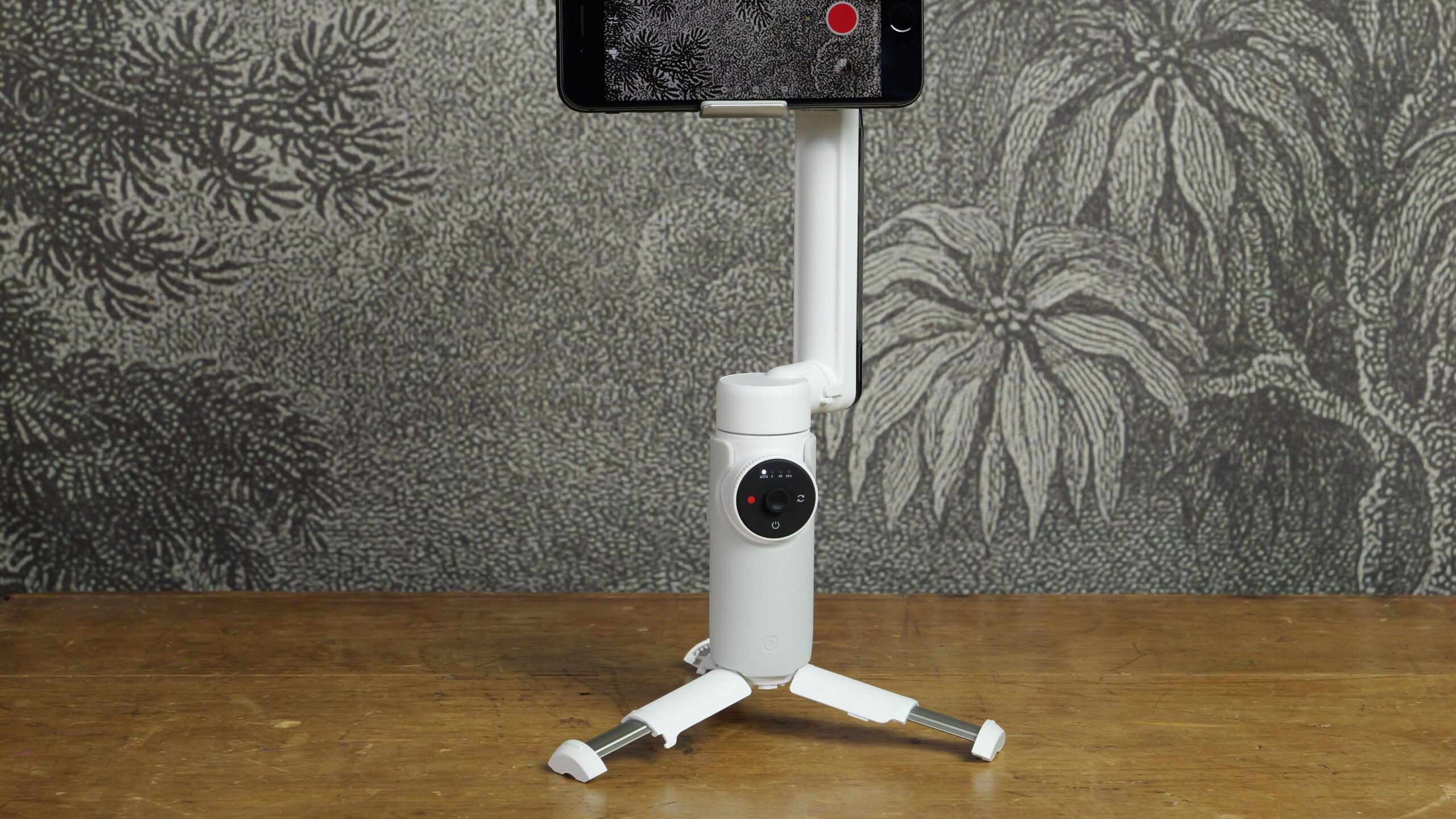Verdict
The best mobile gimbal you can buy, thanks to superb tracking skills and general all-round user friendliness.
Pros
- Best tracking we’ve seen on a smartphone gimbal
- Small, foldable design
- Excellent battery life
- Feature-rich companion app
Availability
- UKRRP: £145
- USARRP: $159
- EuropeRRP: €169
- CanadaRRP: CA$215
- AustraliaRRP: AU$239
-
Smartphone stabilisationEffective stabilisation for any smartphone (within certain size/weight parameters) -
Deep Track 3.0AI-assisted subject tracking with the ability to reacquire obscured subjects -
High-capacity battery2900mAh battery with 12-hour life and power bank feature
Introduction
It’s a well-worn maxim amongst photographers: the best camera is the one you have with you. If a situation arises in which you feel compelled to take a photo (or, perhaps more likely in this day and age, record a video), any camera, no matter how good or bad, is better than none at all.
For most of us, this “any camera” means a smartphone, which will almost always be in your pocket, primed for action when we spot something that must be captured for posterity. So why not make that camera even better by mounting it on something that keeps it supremely stable, beautifully level and able to track moving subjects like a pocket-sized Steadicam.
That’s the thought behind mobile gimbals like the Insta360 Flow (and before it, DJI’s Osmo Mobile range). This is a foldable 3-axis gimbal designed to make life easier for smartphone vloggers and content creators no matter where they are – and despite being Insta360’s first foray into the gimbal market, it’s coming with a very solid feature and spec list, not to mention a price that won’t scare your bank balance to death (in fact, at launch it costs exactly the same as the DJI OM 6).
With all that considered, could the Insta360 Flow be the best mobile gimbal on the market? We spent a few days in its company in order to find out.
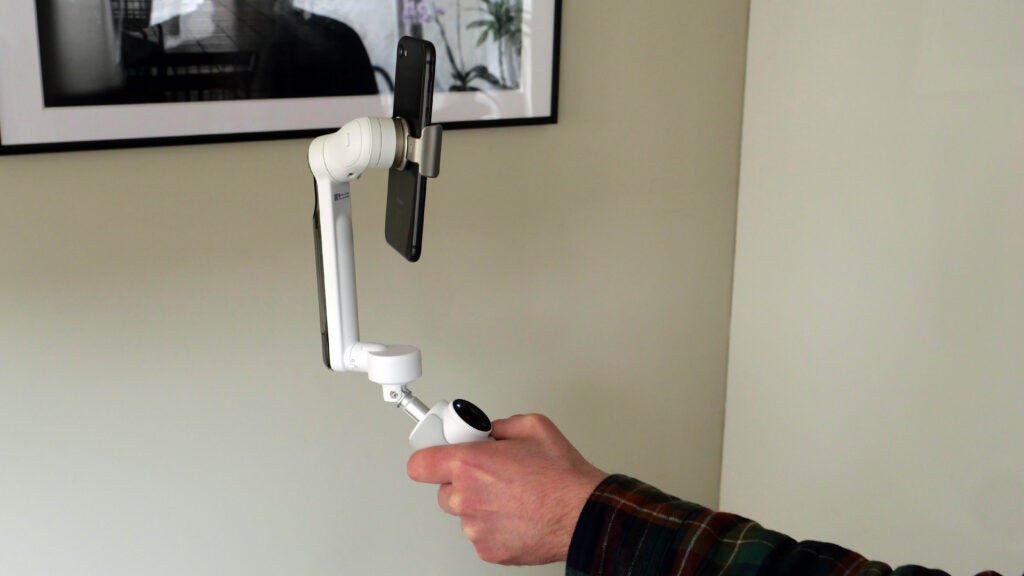
Design
- Foldable and portable design
- Magnet clamp makes mounting easy and quick
- Built-in tripod and selfie stick
There’s no point in owning a mobile gimbal if it’s so bulky or annoying to deploy that you end up leaving it at home. Insta360 understands this, and has clearly put a lot of effort into the Flow’s design. For starters, it’s lightweight (under 400g in total) and compact, folding down to an eminently pocketable 79.6 x 162.1 x 36mm.
When it’s go time (or should that be Flow time?), you can mount your phone in moments thanks to the magnetic clamp (more on that below) and unfold the gimbal arm to its usable position in a single twist; it’ll even power on automatically at the same time. It’s a far cry from the convoluted and fiddly setup of older gimbals, and better even than the DJI OM 5 and 6, which were already pretty fast to deploy.
The magnetic clamp is an idea borrowed from recent models in the DJI OM series, and works in exactly the same way: it’s a spring-loaded clamp that locks around the back and sides of your smartphone, and can snap into place on the top of the gimbal through magnets. It’s secure enough to hold phones up to 300g in weight, between 6.9 and 10mm thick and 64 and 84mm wide, and I never felt like my iPhone 8 was in any danger of toppling off.
The handle is small (in fact I suspect users with larger hands will find it a little too small) but you can pull out both a 215mm extending selfie stick and a mini tripod (the latter of which doubles as a handy grip extender too – good news for those larger handed users). It also has space for a regular tripod mount thread on the bottom as well as a cold shoe for attaching a third-party external microphone.
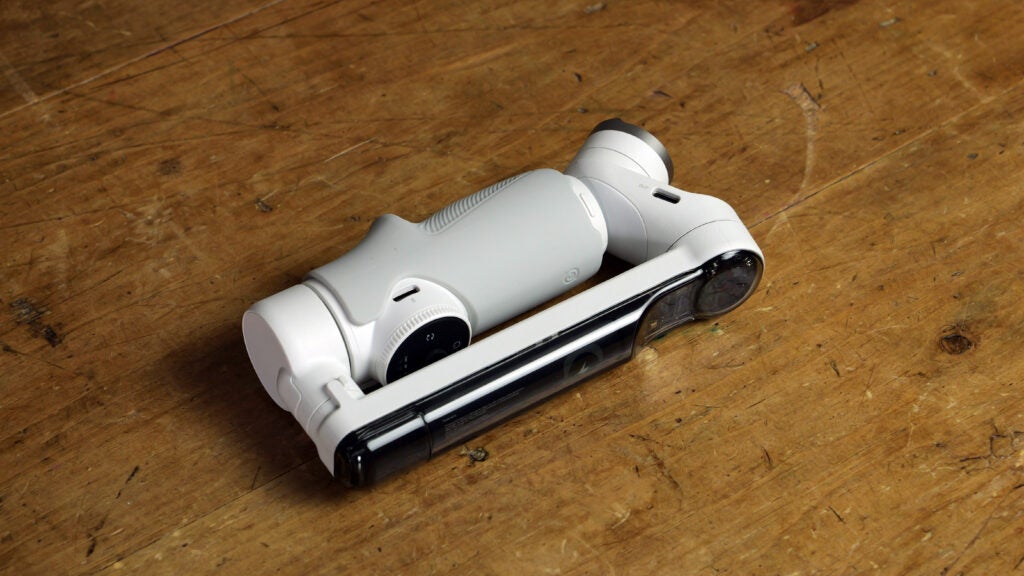
Build quality is excellent too: everything feels sturdy enough for frequent use, both when folded and unfolded. The Flow is mostly made of hard plastic, but there’s a rubber sleeve on the handle to aid grip, while the gimbal arm itself has a transparent cover showing off the battery and some of the circuitry – which is pretty attractive in my opinion, and aesthetically marks this gimbal out from its competitors.
Insta360 has tried to keep physical controls simple, integrating almost everything – power button, record button, mode button, manual movement thumb stick – into a single circular touch panel on the handle; you can swipe your finger around the edge of the panel to switch between the three gimbal modes, although I found this a bit fiddly and would have preferred a button. This panel is also encircled by a wheel that can be jogged left or right to engage your phone camera’s zoom function. The only other control is a trigger on the back of the handle that works in the same way as the OM series’ equivalent: hold it to keep the phone pointing in a single direction; double-tap to re-centre the gimbal; triple-tap to flip the camera 180-degrees so that it faces the opposite direction.
It’s refreshingly easy to control once you’ve had a few minutes to familiarise yourself with it, and the rest of the controls are all contained within the Insta360 app.
App and tracking
- Works with Insta360 mobile app
- AI-assisted subject tracking
- Gesture controls for solo filming
The Flow works with the same Insta360 smartphone app as the company’s action cameras like the Insta360 X3, Insta360 One RS and Insta360 Go 2, but even if you’re not familiar with those you’re unlikely to have many problems getting to grips with it. Once installed and paired with your phone and Flow, it’ll helpfully drop a notification on your phone screen every time the gimbal is switched on. Just tap it to immediately open the app and get started.
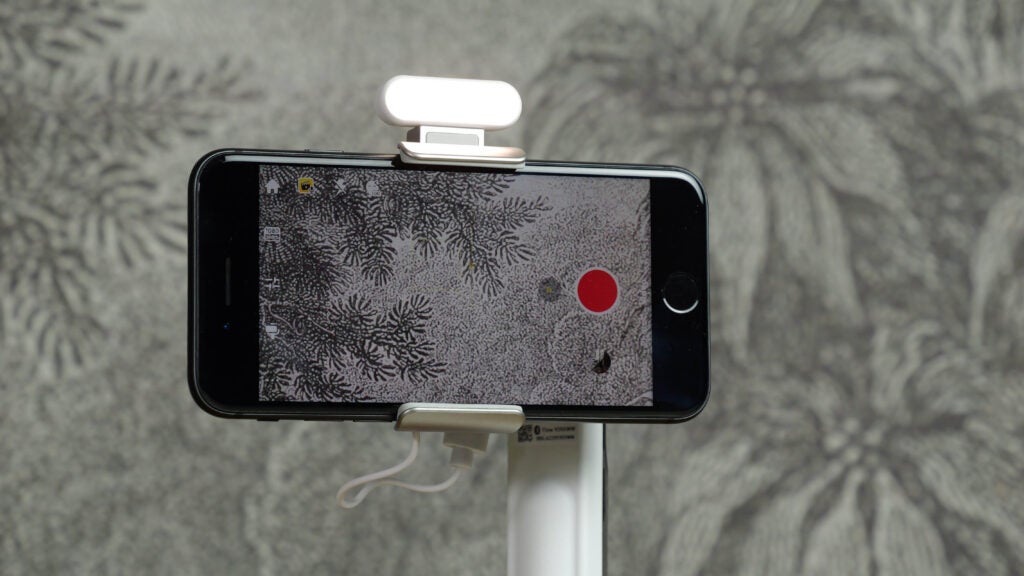
The UI is similar to that of most smartphone camera apps, with a large shutter button in the bottom centre and below it an array of shooting modes that can be swiped through horizontally: Pano Photo; Photo; Video; Timelapse; TimeShift; Slow Motion; Dolly Zoom; and Live Mode. Most of these are self-explanatory: Pano Photo is an automatically shot and stitched panorama, TimeShift is a speed ramped video sequence, Dolly Zoom helps you swiftly recreate the brilliantly jarring zoom effect pioneered by Alfred Hitchcock in Vertigo and Live Mode is live streaming video.
The app also features manual and automatic shooting modes, as well as controls for most of the gimbal settings (although the physical buttons on the gimbal itself are probably less fiddly than this method) and Shot Genie – Insta360’s built-in tutorials for shooting different types of sequences. Shot Genie is a little rigid and didactic for my tastes, as it literally tells you where to point to camera and in what order to take your shots, but for novices looking for a solid grounding in the basics of shot planning and execution for creating narrative sequences, it could be quite instructive and illuminating.
As is customary today, the app also features built-in editing and sharing functionality, although there’s nothing to stop users exporting their videos to a third-party editor and sharing stuff manually. The app’s AI-assisted Shot Lab and FlashCut modes are impressive though: just tag some of your favourite shots, enter some parameters and it’ll whip up a passable edited sequence complete with snazzy transitions and a backing track, all in a matter of seconds.
The real meat of the Flow’s appeal lies in its tracking capabilities, and these are by some way the best I’ve seen on a mobile gimbal. The DJI OM 6 does a fine job of tracking subjects but loses its lock-on as soon as they go out of sight; if the subject reappears, the tracking won’t resume. The Flow’s Deep Track 3.0 tech doesn’t have this problem, and will reacquire its subjects almost every time, leaving the user free to concentrate on important things like not falling over. It’s very impressive and marks the Flow out from its competitors.
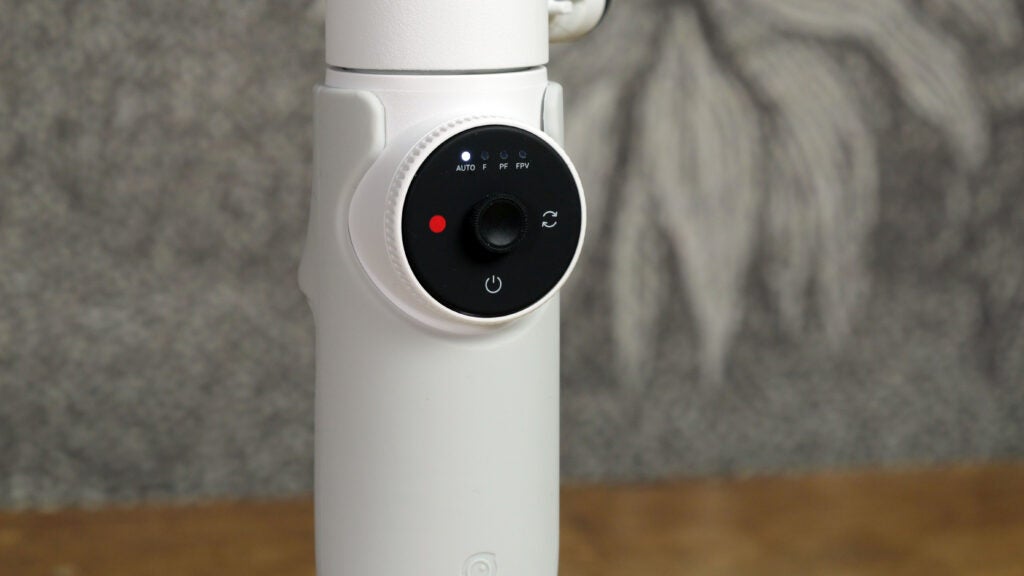
Stabilisation and performance
- 12-hour battery life with power bank function
- Four gimbal movement modes
- Excellent 3-axis stabilisation
The other thing that marks the device out is its battery life. Despite its compact size, there’s a 2900mAh battery built into the Flow and it gives it a brilliant 12-hours of battery life on a full charge – double what you get with the DJI OM 5 and OM 6. Perhaps just as impressive is the fact that the Flow can be used as a power bank: a USB-C port on the gimbal arm lets you top up your phone from the Flow’s battery – even while you’re using the gimbal to capture photos or video.
The gimbal itself works like a charm: it’s brilliant at keeping your phone level, stable and smooth. It features four modes: Auto; Follow; Pan Follow; and FPV. Follow responds quickly to your own movements, Pan Follow is designed for horizontal shooting and keeps the phone more level, and FPV will tilt and pan aggressively almost as if you’re flying a drone. Auto, meanwhile, analyses your movements and selects the best mode of the three accordingly; for the most part it works well, but as you become more familiar with how to use the Flow, you’ll probably want to manually choose your mode prior to filming.
Latest deals
Should you buy it?
You want the best mobile gimbal: The Flow’s AI-assisted tracking skills and long battery life make it the best mobile gimbal around.
You already own a decent mobile gimbal: Don’t chuck out your DJI OM 5 or 6 for the Flow. While it’s better, the differences probably don’t warrant a major cash outlay.
Final Thoughts
Given that this is Insta360’s first ever smartphone gimbal, we were expecting to encounter some teething issues. We never did. The Flow is heavily inspired by DJI’s OM range, it’s true, but it manages to improve upon it thanks to its superb Deep Track 3.0 subject tracking, battery life, power bank function and single-action unfolding – and all at the same price as the DJI OM 6. At the time of writing, we think this is the best mobile gimbal you can buy.
How we test
We test every gimbal for at least a week before delivering a final verdict. Where possible, we will test each gimbal with an iPhone and an Android phone.
Used for more than one week
FAQs
Yes, Insta360 Flow can pair with both iPhones and Android handsets.
While the Insta360 Flow does use a magnetic clasp to hold your smartphone in place, it doesn’t use Apple’s MagSafe technology.
There is a cold shoe on the Insta360 Flow where you can mount an external mic, and a USB-C input port to establish a wired connection.
Sustainability
Trusted Reviews holds the fact that global warming is not a myth as a core value and will continuously endeavor to help protect our planet from harm in its business practices.
As part of this mission, whenever we review a product we send the company a series of questions to help us gauge and make transparent the impact the device has on the environment.
You can see a detailed breakdown of the questions we ask and why in our sustainability info page.
Verdict
The best mobile gimbal you can buy, thanks to superb tracking skills and general all-round user friendliness.
Pros
- Best tracking we’ve seen on a smartphone gimbal
- Small, foldable design
- Excellent battery life
- Feature-rich companion app
Availability
- UKRRP: £145
- USARRP: $159
- EuropeRRP: €169
- CanadaRRP: CA$215
- AustraliaRRP: AU$239
-
Smartphone stabilisationEffective stabilisation for any smartphone (within certain size/weight parameters) -
Deep Track 3.0AI-assisted subject tracking with the ability to reacquire obscured subjects -
High-capacity battery2900mAh battery with 12-hour life and power bank feature
Introduction
It’s a well-worn maxim amongst photographers: the best camera is the one you have with you. If a situation arises in which you feel compelled to take a photo (or, perhaps more likely in this day and age, record a video), any camera, no matter how good or bad, is better than none at all.
For most of us, this “any camera” means a smartphone, which will almost always be in your pocket, primed for action when we spot something that must be captured for posterity. So why not make that camera even better by mounting it on something that keeps it supremely stable, beautifully level and able to track moving subjects like a pocket-sized Steadicam.
That’s the thought behind mobile gimbals like the Insta360 Flow (and before it, DJI’s Osmo Mobile range). This is a foldable 3-axis gimbal designed to make life easier for smartphone vloggers and content creators no matter where they are – and despite being Insta360’s first foray into the gimbal market, it’s coming with a very solid feature and spec list, not to mention a price that won’t scare your bank balance to death (in fact, at launch it costs exactly the same as the DJI OM 6).
With all that considered, could the Insta360 Flow be the best mobile gimbal on the market? We spent a few days in its company in order to find out.

Design
- Foldable and portable design
- Magnet clamp makes mounting easy and quick
- Built-in tripod and selfie stick
There’s no point in owning a mobile gimbal if it’s so bulky or annoying to deploy that you end up leaving it at home. Insta360 understands this, and has clearly put a lot of effort into the Flow’s design. For starters, it’s lightweight (under 400g in total) and compact, folding down to an eminently pocketable 79.6 x 162.1 x 36mm.
When it’s go time (or should that be Flow time?), you can mount your phone in moments thanks to the magnetic clamp (more on that below) and unfold the gimbal arm to its usable position in a single twist; it’ll even power on automatically at the same time. It’s a far cry from the convoluted and fiddly setup of older gimbals, and better even than the DJI OM 5 and 6, which were already pretty fast to deploy.
The magnetic clamp is an idea borrowed from recent models in the DJI OM series, and works in exactly the same way: it’s a spring-loaded clamp that locks around the back and sides of your smartphone, and can snap into place on the top of the gimbal through magnets. It’s secure enough to hold phones up to 300g in weight, between 6.9 and 10mm thick and 64 and 84mm wide, and I never felt like my iPhone 8 was in any danger of toppling off.
The handle is small (in fact I suspect users with larger hands will find it a little too small) but you can pull out both a 215mm extending selfie stick and a mini tripod (the latter of which doubles as a handy grip extender too – good news for those larger handed users). It also has space for a regular tripod mount thread on the bottom as well as a cold shoe for attaching a third-party external microphone.

Build quality is excellent too: everything feels sturdy enough for frequent use, both when folded and unfolded. The Flow is mostly made of hard plastic, but there’s a rubber sleeve on the handle to aid grip, while the gimbal arm itself has a transparent cover showing off the battery and some of the circuitry – which is pretty attractive in my opinion, and aesthetically marks this gimbal out from its competitors.
Insta360 has tried to keep physical controls simple, integrating almost everything – power button, record button, mode button, manual movement thumb stick – into a single circular touch panel on the handle; you can swipe your finger around the edge of the panel to switch between the three gimbal modes, although I found this a bit fiddly and would have preferred a button. This panel is also encircled by a wheel that can be jogged left or right to engage your phone camera’s zoom function. The only other control is a trigger on the back of the handle that works in the same way as the OM series’ equivalent: hold it to keep the phone pointing in a single direction; double-tap to re-centre the gimbal; triple-tap to flip the camera 180-degrees so that it faces the opposite direction.
It’s refreshingly easy to control once you’ve had a few minutes to familiarise yourself with it, and the rest of the controls are all contained within the Insta360 app.
App and tracking
- Works with Insta360 mobile app
- AI-assisted subject tracking
- Gesture controls for solo filming
The Flow works with the same Insta360 smartphone app as the company’s action cameras like the Insta360 X3, Insta360 One RS and Insta360 Go 2, but even if you’re not familiar with those you’re unlikely to have many problems getting to grips with it. Once installed and paired with your phone and Flow, it’ll helpfully drop a notification on your phone screen every time the gimbal is switched on. Just tap it to immediately open the app and get started.

The UI is similar to that of most smartphone camera apps, with a large shutter button in the bottom centre and below it an array of shooting modes that can be swiped through horizontally: Pano Photo; Photo; Video; Timelapse; TimeShift; Slow Motion; Dolly Zoom; and Live Mode. Most of these are self-explanatory: Pano Photo is an automatically shot and stitched panorama, TimeShift is a speed ramped video sequence, Dolly Zoom helps you swiftly recreate the brilliantly jarring zoom effect pioneered by Alfred Hitchcock in Vertigo and Live Mode is live streaming video.
The app also features manual and automatic shooting modes, as well as controls for most of the gimbal settings (although the physical buttons on the gimbal itself are probably less fiddly than this method) and Shot Genie – Insta360’s built-in tutorials for shooting different types of sequences. Shot Genie is a little rigid and didactic for my tastes, as it literally tells you where to point to camera and in what order to take your shots, but for novices looking for a solid grounding in the basics of shot planning and execution for creating narrative sequences, it could be quite instructive and illuminating.
As is customary today, the app also features built-in editing and sharing functionality, although there’s nothing to stop users exporting their videos to a third-party editor and sharing stuff manually. The app’s AI-assisted Shot Lab and FlashCut modes are impressive though: just tag some of your favourite shots, enter some parameters and it’ll whip up a passable edited sequence complete with snazzy transitions and a backing track, all in a matter of seconds.
The real meat of the Flow’s appeal lies in its tracking capabilities, and these are by some way the best I’ve seen on a mobile gimbal. The DJI OM 6 does a fine job of tracking subjects but loses its lock-on as soon as they go out of sight; if the subject reappears, the tracking won’t resume. The Flow’s Deep Track 3.0 tech doesn’t have this problem, and will reacquire its subjects almost every time, leaving the user free to concentrate on important things like not falling over. It’s very impressive and marks the Flow out from its competitors.

Stabilisation and performance
- 12-hour battery life with power bank function
- Four gimbal movement modes
- Excellent 3-axis stabilisation
The other thing that marks the device out is its battery life. Despite its compact size, there’s a 2900mAh battery built into the Flow and it gives it a brilliant 12-hours of battery life on a full charge – double what you get with the DJI OM 5 and OM 6. Perhaps just as impressive is the fact that the Flow can be used as a power bank: a USB-C port on the gimbal arm lets you top up your phone from the Flow’s battery – even while you’re using the gimbal to capture photos or video.
The gimbal itself works like a charm: it’s brilliant at keeping your phone level, stable and smooth. It features four modes: Auto; Follow; Pan Follow; and FPV. Follow responds quickly to your own movements, Pan Follow is designed for horizontal shooting and keeps the phone more level, and FPV will tilt and pan aggressively almost as if you’re flying a drone. Auto, meanwhile, analyses your movements and selects the best mode of the three accordingly; for the most part it works well, but as you become more familiar with how to use the Flow, you’ll probably want to manually choose your mode prior to filming.
Latest deals
Should you buy it?
You want the best mobile gimbal: The Flow’s AI-assisted tracking skills and long battery life make it the best mobile gimbal around.
You already own a decent mobile gimbal: Don’t chuck out your DJI OM 5 or 6 for the Flow. While it’s better, the differences probably don’t warrant a major cash outlay.
Final Thoughts
Given that this is Insta360’s first ever smartphone gimbal, we were expecting to encounter some teething issues. We never did. The Flow is heavily inspired by DJI’s OM range, it’s true, but it manages to improve upon it thanks to its superb Deep Track 3.0 subject tracking, battery life, power bank function and single-action unfolding – and all at the same price as the DJI OM 6. At the time of writing, we think this is the best mobile gimbal you can buy.
How we test
We test every gimbal for at least a week before delivering a final verdict. Where possible, we will test each gimbal with an iPhone and an Android phone.
Used for more than one week
FAQs
Yes, Insta360 Flow can pair with both iPhones and Android handsets.
While the Insta360 Flow does use a magnetic clasp to hold your smartphone in place, it doesn’t use Apple’s MagSafe technology.
There is a cold shoe on the Insta360 Flow where you can mount an external mic, and a USB-C input port to establish a wired connection.
Sustainability
Trusted Reviews holds the fact that global warming is not a myth as a core value and will continuously endeavor to help protect our planet from harm in its business practices.
As part of this mission, whenever we review a product we send the company a series of questions to help us gauge and make transparent the impact the device has on the environment.
You can see a detailed breakdown of the questions we ask and why in our sustainability info page.



















